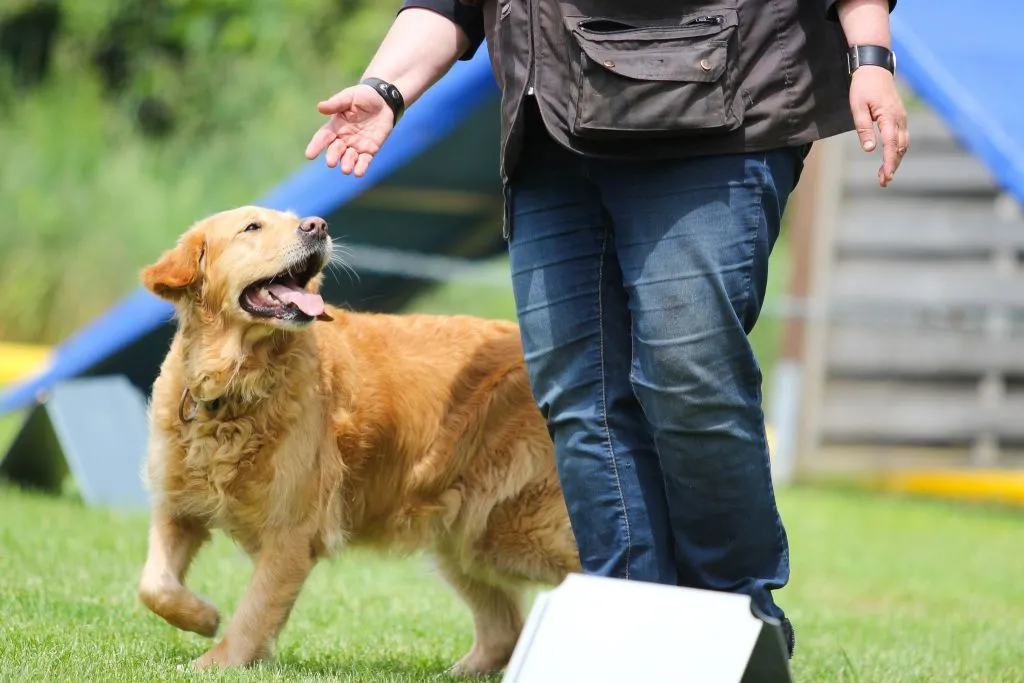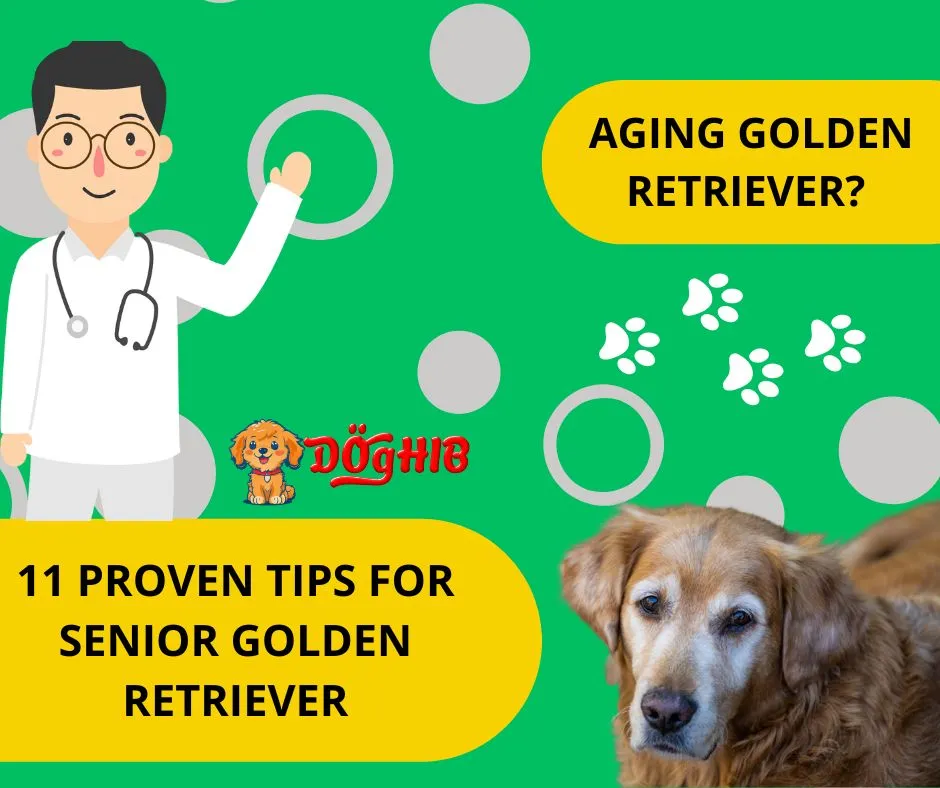
Golden Retrievers are known for their playful nature and love for exercise. But as your Golden Retriever grows and ages, their exercise needs change.
So, how much exercise does a Golden Retriever need on a daily basis?
Normally, your Golden Retriever needs around 60-90 minutes of exercise per day. However, as they grow and age, their exercise needs evolve. requiring us to adapt our routines accordingly. This means that we need to be flexible and adjust our routines accordingly to ensure their well-being and vitality.
But how can you tell if your Golden Retriever isn’t getting enough exercise?
- Restlessness and Excessive Energy: If your Golden Retriever seems to have an excess of energy, displaying restlessness or engaging in destructive behaviors, it could be an indication that they need more exercise.
- Weight Gain: Lack of exercise can contribute to weight gain in dogs, which can lead to various health problems. If you notice your Golden Retriever gaining weight, it might be a sign that they need to engage in more physical activity.
- Behavioral Issues: Insufficient exercise can result in behavioral issues such as excessive barking, digging, or hyperactivity. Regular exercise helps channel their energy in a positive way and reduces the likelihood of these problems.
If you notice any of these signs in your Golden Retriever, it’s a clear indication that they need more exercise. But before you jump into action, it’s crucial to consider their age and familiarize yourself with DogHIB’s Golden Exercise Guidelines tailored to each stage of their life.
Table of Contents
How much exercise does a Golden Retriever puppy need in the puppy stage? (Birth to 6 months)
During the puppy stage, it’s important to strike a balance between allowing them to explore and play while avoiding excessive exercise that could strain their still-developing bodies. Let’s break down the exercise needs of Golden Retriever puppies in the different months:
- Birth to 1 month: Limit exercise to short, supervised play sessions and gentle movements.
- 1 to 2 months: Gradually increase exercise to around 5 minutes per day. Short walks on a leash are beneficial.
- 2 to 3 months: Increase exercise to about 10 minutes per day. Continue with short walks and interactive play.
- 3 to 4 months: Extend exercise to approximately 15 minutes per day. Increase the frequency of walks and introduce basic training exercises.
- 4 to 5 months: Aim for around 20 minutes of exercise per day. Continue with walks and incorporate mentally stimulating activities.
- 5 to 6 months: Increase exercise to approximately 25 minutes per day. Continue with walks and include short bursts of controlled running or jogging.
Pro Tip: Avoid excessive exercise as it can lead to injuries or skeletal issues. Keep a close eye on your puppy’s energy levels and make adjustments to the duration and intensity of exercise accordingly.
How much exercise does an Adolescent Golden Retriever need in the Adolescence stage? (6 months to 18 months)
As your Golden Retriever enters adolescence, you can gradually increase the intensity and duration of their exercise.
Pro Tip: Increase their activity by 5 minutes each month until they hit one year. After that, aim for around 25-30 minutes of exercise two times a day, sometimes more, to keep them happy and healthy.
Longer walks, off-leash play in a secure area, and supervised swimming sessions are excellent ways to provide the necessary physical activity.
Along with physical exercise, it’s crucial to stimulate their minds. Incorporate obedience training sessions and introduce puzzle toys to challenge their intelligence. Mental stimulation is just as important as physical exercise for their overall well-being.
How much exercise does an Adult Golden Retriever need in the Adult stage (1 to 8 years)?
Adult Golden Retrievers are known for their peak energy levels and vitality.
Set a consistent exercise routine that includes daily walks, jogging, hiking, and interactive games. Engaging in activities that allow them to burn off their energy will contribute to their overall happiness and well-being.
Here’s an exercise routine for a day for an adult Golden Retriever:
Morning:
- A 20-minute brisk walk around the neighborhood.
Afternoon:
- 15-minute interactive play session with a ball or toy.
Evening:
- 30-minute jog or run in a park or open area.
Adjust the intensity and duration of exercise based on your dog’s energy levels and physical capabilities.
Pro Tip: Avoid exercising during the hottest parts of the day to prevent overheating, especially if your Golden Retriever has a darker coat color. Opt for shaded areas or cooler times of the day.
Related: Golden Retriever Summer Guide

As we have discussed, you’ll easily notice if your Golden Retriever hasn’t received sufficient exercise. But how do you know if your furry friend has had enough exercise?
Here are a few indicators that your furry friend has had a fulfilling workout:
- Calmer Demeanor: After a satisfying exercise session, your Golden Retriever should exhibit a calmer demeanor, showing signs of contentment and relaxation.
- Healthy Appetite: Regular exercise often stimulates their appetite, and a healthy appetite is a positive sign that they have expended energy during their physical activities.
- Good Sleep Patterns: Sufficient exercise promotes better sleep quality. If your Golden Retriever enjoys restful sleep patterns, it’s likely that they’ve received adequate exercise.
How much exercise does a Senior Golden Retriever need in the Senior stage? (8 years and older)
In the senior stage of a Golden Retriever’s life, their energy levels may decrease, and they may face certain health challenges.
Engage in low-impact exercises, such as gentle walks, swimming, and short play sessions, to keep your senior Golden Retriever active without putting excessive strain on their aging bodies.
Be flexible in adapting the exercise routine to accommodate your senior Golden Retriever’s changing needs. Provide ample rest periods and listen to their cues to prevent overexertion or discomfort.
Related: Golden Retriever Aging Care Tips and Tricks
It’s essential to monitor your senior Golden Retriever’s health closely. Regular veterinary check-ups can help identify any age-related limitations or health issues that may require adjustments to their exercise routine.
Safety Tips for Exercising Golden Retrievers
When it comes to exercising your Golden Retriever, safety should always be a top priority. Here are some important safety tips to keep in mind:
Warm-up and Cool-down
- Importance of Warming Up: Just like humans, dogs benefit from a warm-up before engaging in more vigorous activities. Consider starting exercise sessions with light stretching or short walks to help prevent injuries.
- Cool-down Activities: After a workout, incorporate cool-down activities to help your Golden Retriever gradually return to a resting state. This can include a gentle walk or some stretching exercises.
Environmental Considerations
- Safe Exercise Environments: Choose safe and suitable areas for exercising your Golden Retriever. Avoid extreme temperatures, rough terrains, or crowded areas that may pose risks to their well-being.
- Adaptation to Weather Conditions: During hot weather, plan exercise sessions in the cooler parts of the day, such as early morning or evening, to prevent heat-related issues. In colder weather, consider protective gear to keep your furry friend warm.
Hydration and Rest
- Stay Hydrated: Provide fresh water for your Golden Retriever before, during, and after exercise sessions. Hydration is crucial to prevent dehydration and maintain their well-being.
- Rest Periods: Allow your Golden Retriever to rest and recover between exercise sessions. Adequate rest is essential for their muscles to recuperate and prevent exhaustion.

11 Tried-and-Tested Exercises to Keep Your Golden Retriever Active
- Daily Walks: Take your Golden Retriever for a brisk walk in the neighborhood or a nearby park. It provides essential physical exercise and helps them explore the world around them.
- Off-Leash Fun: Find a secure, fenced area where your Golden Retriever can enjoy off-leash playtime. Let them run, chase balls, and interact with other friendly dogs.
- Swimming Sessions: Golden Retrievers love water! If possible, take them to a dog-friendly beach or swimming pool. Swimming is a fantastic low-impact exercise that works their muscles and keeps them cool.
- Interactive Fetch Games: Engage in a lively game of fetch using their favorite toys. It’s a great way to work on their natural retrieval instincts and give them a good workout.
- Tug-of-War: Grab a sturdy rope toy and play a spirited game of tug-of-war with your Golden Retriever. It helps build their strength and provides mental stimulation.
- Agility Training: Set up an agility course in your backyard or join a local training facility. Golden Retrievers excel in agility activities, which challenge them both physically and mentally.
- Hiking Adventures: Take your Golden Retriever on nature hikes or trails that allow dogs. They’ll love exploring new scents, sights, and terrains while getting a solid workout.
- Canine Sports: Engage your Golden Retriever in canine sports such as dock diving, flyball, or obedience trials. These activities tap into their athleticism and provide a fun challenge.
- Puzzle Toys and Treat Dispensers: Stimulate their mind with puzzle toys or treat-dispensing toys. These interactive toys keep them mentally engaged and provide a rewarding exercise for their problem-solving skills.
- Doggy Playdates: Arrange playdates with other friendly dogs in a safe and supervised environment. It allows them to socialize, burn off energy, and engage in playful interactions.
- Hide and Seek: Hide treats or their favorite toys around the house or yard and encourage your Golden Retriever to find them. It’s a mentally stimulating game that taps into their natural scenting abilities.
Each Golden Retriever is unique, so adapt these exercise methods to suit their age, energy levels, and any specific health considerations. Regular exercise is essential for their overall well-being and helps prevent behavioral issues caused by excess energy. So, get out there and have a blast with your furry friend!
Conclusion
A well-exercised Golden Retriever is a happy and balanced one. Meeting their exercise needs at every age is the key to their vitality and happiness.
-Sanjay Dhakal
Understanding the exercise needs of your Golden Retriever at different stages of life is crucial for their overall health and happiness. From puppyhood to their golden years, tailoring the exercise routine to their age and energy levels will contribute to their well-being and longevity.
Gradually increase Golden Retriever exercise intensity, provide mental stimulation, and monitor their responses to ensure their exercise needs are met. By incorporating regular exercise into their routine and considering safety precautions, you can help your Golden Retriever lead a healthy and fulfilling life.
We hope DogHIB’s Golden Exercise Guidelines have been helpful to you!
Feel free to leave a comment and share this valuable information with other dog owners.



